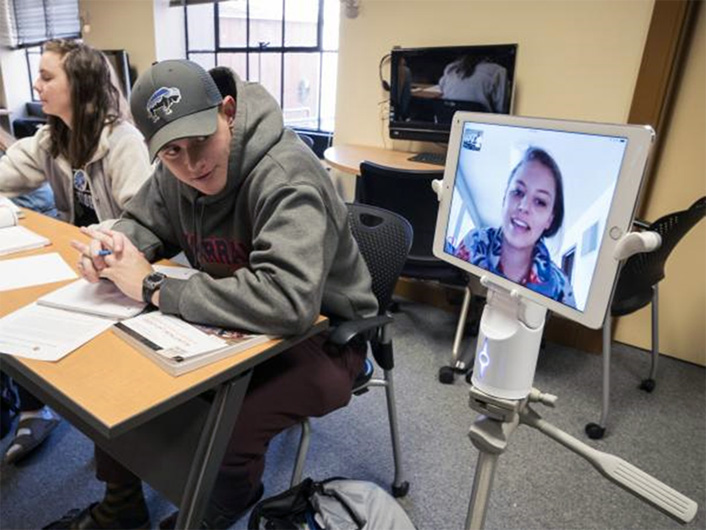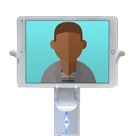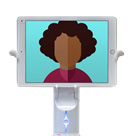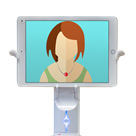Telepresence robotics allows students who are temporarily unable to attend their classes to continue participating remotely.

In higher education, we often encounter students who are experiencing unexpected setbacks that impact their ability to attend class. Whether it's due to a car accident, a family emergency, or an illness, the inability to get to class can have a lasting effect on a student's academic success. Often, students experience excessive stress trying to catch up on missed coursework. In some cases, they have no choice other than to withdraw from their classes, putting them a semester or more behind and delaying degree completion — if they return at all.
The right solution to help students with short-term needs is not always readily available. Institutions can grant them special accommodations and flexibility, extending assignment deadlines or offering alternate exam dates, but such solutions often fail to provide comparable learning experiences. Absent students miss in-class opportunities for interaction and collaboration, which limits their full learning potential. Further, instructors often experience added workload stress from managing student accommodations, which range from creating alternate assignments to scheduling locations and times for make-up exams to grading work at the last minute. Ultimately, these circumstances can result in a less-than-optimal course experience for everyone involved.
Like many institutions, the University of Colorado Boulder (CU Boulder) is working to retain and graduate our students. As part of that effort, we asked how we might support students who find themselves in situations that force them to miss classes but who might otherwise have successful academic careers. Typical solutions, such as leveraging lecture capture or video conferencing, are expensive and not always suitable for temporary, unexpected situations or for classes where interaction and participation are important. With this in mind, we looked into telepresence robotics as a potential solution for enabling students to attend class remotely.
Telepresence robots are remotely controlled video conferencing devices that are increasingly used in fields such as business and healthcare. As this technology has become more affordable and accessible, higher education institutions have been exploring the capabilities of telepresence robots for distance learning and remote classroom attendance. One example is Michigan State University, which tested the use of Double and Kubi telepresence robots in combination with video conferencing software to let students participate in courses remotely. At CU Boulder, we recently had the opportunity to conduct a pilot study that brought remote students into the classroom using telepresence robots.
The Pilot Study: Enabling Engagement
CU Boulder's previous experiment using a telepresence system in an Italian course encouraged our Academic Technology Design Team (ATDT) in the Office of Information Technology (OIT) to explore how such a system might effectively support teaching and learning for our target population: students who cannot attend classes on campus due to extenuating circumstances. After receiving funding through CU Boulder's Innovation Grant, we launched our pilot study.
Based on our research of telepresence systems, and given the previous experiment's success, we chose to continue with the same system: Kubi, an affordable, easy-to-implement telepresence robot. As Figure 1 shows, Kubi is a robotic "neck" that holds a tablet. From their own computers, remote students are able to see, hear, and speak with their instructor and classmates through the tablet's camera and microphone. Remote users can control their viewpoint using their keyboard arrow controls to move the Kubi and the attached tablet up to 320 degrees side-to-side and 90 degrees up and down. This gives students an active, physical presence in the classroom and lets them engage with instructors and peers to fully participate in learning activities.

With our grant funding, we purchased 10 Kubis and 10 iPads to launch a pilot in Spring 2017. We identified potential students to participate in our pilot by reaching out to various support offices on campus that would have been contacted by students in need. This helped us find students who were likely to miss a significant number of class sessions or withdraw from their courses entirely due to extenuating circumstances but who still wanted to attend class.
During our pilot, 11 students attended a total of 302 class sessions with very positive results. We found that telepresence robots are most useful in smaller, interactive classes that require student participation. If placed toward the front of the classroom, our Kubi setup was also useful in larger classrooms that did not already utilize lecture capture. Our team provided initial Kubi trainings for instructors and remote students, and we used student employees and volunteers to deliver and set up the technology for each class session. Because instructors did not have to put in a significant amount of additional time to support remote students, they were willing to accommodate the students using Kubi.
Student Experiences
The following stories illustrate the variety of circumstances in which telepresence robots can be used, as well the impact this support can have on a student's academic career. We changed participants' names and slightly altered other identifying characteristics to protect their privacy; the images were designed by Peter Cullum, University of Colorado, and are used with permission.
Marcus

Marcus, a third-year engineering major, had to be away from campus for the first six weeks of the semester to undergo medical treatment. Alternating between two Kubis, he was able to remotely participate in three classes with the support of his instructors, a departmental technology partner, and a fellow classmate who served as a "Kubi Buddy," delivering the technology and troubleshooting as needed. Marcus then learned that medical complications would prevent him from returning to campus for the entire semester. However, he was able to continue using the telepresence robots to attend his classes without any additional effort on the instructors' part.
I was not a distraction to [my classmates], as I could move myself and position myself to see either the board or my professor as she moved around the room. All in all, my experience using the Kubi was very helpful throughout the time that I needed it, as it allowed me to be present in class and stay on track with my studies.
Sandra

Sandra, a sophomore political science major, initially used a Kubi to attend a second-semester Arabic class for four weeks while recovering from surgery following a sports-related injury. When she first confronted this situation, Sandra was concerned that she would have to withdraw from classes and would fall behind academically. She also worried that withdrawing in the spring semester would mean that she would not be able to resume her language classes until the fall and would thus risk losing her Arabic skills. However, the support of the academic department — and especially the instructor — let Sandra actively participate in this immersive language class with a telepresence robot. When Sandra needed a subsequent surgery in the fall, she was again able to continue her language learning using the robot.
Without the Kubi, I would have been unable to attend class every day, which would have left me significantly behind in the course. It was my hope to stay on track with the language and not fall behind, and the Kubi made that possible.
Aisha

Aisha, a sociology major, attended numerous classes via a Kubi telepresence robot while recovering from surgery. Two of Aisha's large lecture courses used lecture capture, which meant she could view these classes remotely. However, the remainder of her classes, particularly her recitations, required her active participation. Aisha continued engaging with these classes with the help of the telepresence technology. Her instructors saw the effort she put into attending class each day and were relieved not to have to consider alternate options for her assignments.
Thank you so much! This program has allowed me to stay on top of my work and really decreased my stress. I was a bit nervous the faculty might be hesitant about this technology, but I'm glad everyone has responded so positively!
Amanda

Partway through her junior year, Amanda was injured in a car accident. After reviewing her rigorous course load, she realized her options were to drop her classes or struggle through the rest of the semester and risk lowering her GPA. Luckily, her upper-division Portuguese instructor was aware of the Kubi pilot and helped facilitate getting Amanda set up on the telepresence system. Although she had to drop the rest of her classes due to the stress of her workload, she was able to stay enrolled in this five-credit language class and successfully complete the course.
Study Results
To measure the success of our pilot, we surveyed and interviewed the remote students, their instructors, and a Kubi Buddy throughout the semester. The data indicated an overall positive experience for the remote students and their instructors, as well as their classmates.
System Advantages
As the stories above describe, students dealing with difficult situations were successfully able to attend and participate in their classes remotely via the telepresence robots instead of missing class sessions or dropping classes entirely. Also, instructors indicated that incorporating the system into their classrooms required minimal effort. For our team, the Kubis were easy to deliver to each classroom, set up, and move to other classrooms as needed.
The students supported through telepresence robotics each had unique stories and individual needs. Our niche technology initiative not only allowed these students to continue with their coursework but also let them have comparable educational experiences to those of students attending class in-person.
Our initiative's small scale allowed for flexibility and nimbleness in tailoring the solution to meet the needs of this specific student population. The pilot's personal nature also let us accommodate the students' changing (and sometimes urgent) needs and show them that CU Boulder was willing to support them.
We found that using the Kubi telepresence system offered many benefits:
- Persistence and retention. Overall, using the system helped students remain successful in their classes by providing an easy option to overcome challenging circumstances. This was particularly true for sequenced classes, such as foreign languages.
- Student empowerment. The system empowers students experiencing setbacks and other serious life challenges, letting them demonstrate to their instructors, their classmates, and themselves that they want to be in class and are committed to learning.
- Comparable learning experiences. While other technologies might allow only one-way communication or asynchronous learning, telepresence robotics facilitates active participation and peer interactions during class.
- Easy implementation. The system offers a flexible, affordable, and simple solution. Training students and instructors is a relatively quick process, while supporting documentation — such as our Kubi Quick Start Guide and "Kubi Tips" [http://tinyurl.com/kubi-tips]— minimizes potential technology issues.
- Minimal impact on instructors. Although instructors require some training to integrate the system into their classroom, its actual use is typically easier for instructors than extending deadlines, changing assignments, or scheduling alternate exam days.
- Empowerment for student-support staff. In terms of the services we provide students on our campus, the pilot helped us identify and fill a gap: It let us provide immediate, short-term assistance for students who were experiencing temporary setbacks. The telepresence robot used in our study offered a viable solution that empowered our staff to help students who may have had no other options.
Issues and Challenges
Kubi offered an innovative and immediate solution to help students who might not be able to leverage other campus support services. However, as with any new campus program or service, effectively implementing such a technology can pose various challenges.
First, informing instructors and relevant staff (such as advisors and student support offices) about the system's availability and affordances takes some effort, especially on a large, decentralized campus. Explaining by phone or email what a telepresence robot is and how it works can be difficult, so it is incredibly helpful to offer demonstrations of the technology. Early in our pilot study, we met with instructors, students, and campus entities that were interested in using the technology. These demonstrations are crucial; if students and instructors do not understand the technology, they might request it for inappropriate circumstances. For example, they might think it would be possible to use a telepresence robot to attend class asynchronously.
Logistically, it is necessary to schedule system delivery and technology support for various classes, which is both time and resource intensive. Further, day-to-day coordination with each remote student is important to ensure successful implementation, as well as to avoid unnecessary system delivery if a student must miss a class (e.g., due to a doctor's appointment).
In terms of technical requirements, Kubis integrate with video conferencing software and therefore rely on a strong WiFi signal in the classroom and strong WiFi or a high-speed internet connection in the remote student's environment. The student experience is also greatly dependent on the tablet's audio and video capabilities. It is possible to leverage supplemental speakers and microphones, but doing so can introduce additional issues and complicate training.
Finally, while we found the system easy to use, it is essential to provide training beforehand for remote students as well as for instructors and classmates. For example, remote students must be trained in using video conferencing software to control the device, while instructors should make sure the remote student is included in learning activities. Also, it is important that classmates treat the telepresence setup as a student in the physical classroom. Therefore, it is necessary to provide trainings and determine the level of training needed for both the technology and pedagogy. In our case, the campus determined that OIT would provide Kubi telepresence robots as a service and designate a Kubi service manager to coordinate and manage trainings and system use.
Supporting Individual Student Success
As a result of its success, what started as a short-term technology pilot has expanded to an ongoing service at CU Boulder. The implementation of telepresence robotics on our campus both supplements existing student support services and reflects CU Boulder's commitment to helping students in need.
By partnering with supportive instructors, classmates, and staff, students experiencing setbacks can continue to actively engage in their learning. These collaborative partnerships supported our pilot of a technology that promises to offer highly impactful support for students who might otherwise fall through the cracks. Some of our pilot students did have to withdraw from other classes. In classes where Kubi support was possible, students were able to remain in control of their academic life in spite of adverse circumstances. Finally, many students noted that the pilot demonstrated that CU Boulder cares about individual student success — a sentiment that is all the more valuable in times that focus on large-scale impact.
Doris Cheung is a Learning Experience Designer on the Academic Technology Design Team in the University of Colorado Boulder's Office of Information Technology.
Tarah Dykeman is a Learning Experience Design Assistant on the Academic Technology Design Team in the University of Colorado Boulder's Office of Information Technology.
Courtney Fell is a Learning Experience Designer on the Academic Technology Design Team in the University of Colorado Boulder's Office of Information Technology.
© 2018 Doris Cheung, Tarah Dykeman, and Courtney Fell. The text of this work is licensed under a Creative Commons BY-NC-ND 4.0 International License.
